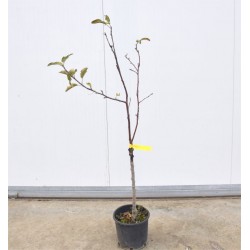Goldrich apricot tree
Generalies:
Apricot Goldrich is a medium-early or intermediate ripening plant of American origin and obtained in the state of Washington from H. Google. Medium vigorous tree with upright growth habit, medium productivity and non-compatible or partially self-fertile with the need for pollinators such as Bella d'Imola, Portici and Sabbatani. Fruit on bunches of May and toasts. The large or very large fruit, oval-triangular, of an intense orange color without overcolour with high maturation resistance. Orange flesh, high consistency and stands out. Mediocre taste qualities and acid taste, acid peel and poor juiciness.
- Jar 16cm, height 120/160cm
- jar 22cm, height 150/170cm
Generalities:
Apricot Goldrich is a cultivar that can count on a high vigor, an average productivity level (which is also quite constant when pruning and pollination are carried out regularly). The fruits are characterized by having an excellent hold on the plant, allowing the production of Goldrich for a rather long period. The flowering of the Goldrich variety begins during the first ten days of March and the harvest, however, takes place during the second decade of June. The variety of Goldrich apricots has an average weight of about 90 grams, with a peel that has a rather fascinating intense orange color: the use of these fruits is intended, in most cases, for fresh consumption. The pulp has an orange color; the gustatory quality is discreet, especially when it reaches an advanced ripening period, even if the acidity level rises slightly in the skin. In most cases, the plantations of the Goldirch apricot variety take place in the plains and hills.
Cultivation and Care :
The Apricot Tree can be grown in the plains as well as in altitude. As for the exposure, it is preferable to place the plant in a partially ventilated and moisture-free area; this serves the prevention of fungal diseases, adversities to which the apricot is unfortunately very subject. It goes without saying that apricot trees, like most fruit and non-fruit trees, are very afraid of water stagnation.For the planting, which can be carried out from October to April, a hole is excavated about 60 cm deep and 80 cm wide; at the bottom of the hole it is advisable to put 100-150 g of cornunghia (a fertilizer of animal origin); then fill the hole halfway with soil mixed with planting soil and possibly a little manure. At this point you can insert the plant and fill the hole with the earth previously excavated. At the end, irrigate the area with about 20 liters of water. It can help to put a guardian on the plant to guide its development. As for irrigation interventions, keep in mind that apricot is not a particularly demanding plant; taking due account of any rainfall, irrigation must be characterized by a certain regularity; avoid plenty of water when we are close to the harvest period. The most suitable irrigation systems for apricot trees are drip or spray irrigation.




















